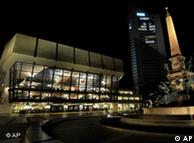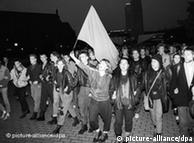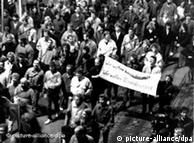East Germany | 09.10.2009
20 years on, Leipzig celebrates "peaceful revolution"
Several high-ranking politicians were in Leipzig for the ceremonies commemorating the demonstrations that took place there 20 years ago, including Chancellor Angela Merkel.
In a speech delivered in the Gewandhaus music hall, Merkel called on Germans to continue the spirit of democracy that was kindled on the streets of Leipzig 20 years ago.
German President Horst Koehler called October 9 a "great and happy day in the history of Germany," speaking just steps away from where the demonstrations began.
 Bildunterschrift: Großansicht des Bildes mit der Bildunterschrift: The commemoration is to begin at the Gewandhaus concert hall
Bildunterschrift: Großansicht des Bildes mit der Bildunterschrift: The commemoration is to begin at the Gewandhaus concert hall
The "peaceful revolution" began in front of the Nikolaikirche church in the city center. Like all of the "Montagsdemonstrationen," the peaceful demonstrations that had been occurring each Monday for over three months, the gathering commenced in front of the Nikolaikirche, a Lutheran church. This Monday, however, was the most historic of them all.
At least 70,000 East Germans turned up to protest against the oppressive regime of the German Democratic Republic (GDR). The massive procession that evening made its way through the entire city center.
A "festival of light" to mark the anniversary
Unlike similar demonstrations that had already taken place in other East German cities like East Berlin and Dresden, security forces did not stop or disperse the crowds, even though the authorities had threatened to use force.
 Bildunterschrift: Großansicht des Bildes mit der Bildunterschrift: A fortnight later, there were "Montagsdemonstrationen" on the streets of Berlin, too
Bildunterschrift: Großansicht des Bildes mit der Bildunterschrift: A fortnight later, there were "Montagsdemonstrationen" on the streets of Berlin, too
This restraint by the authorities is viewed by many as the beginning of the end of the dictatorship in communist East Germany. It showed that the political will and ability to suppress public discontent was fading amongst East Germany's ruling elite, especially as the protests continued to grow in size.
One week later, with public confidence buoyed by the success of the past protest, 120,000 people turned up for the next installment of the Leipzig "Monday demonstrations". Again, the authorities did not intervene. Before long, there were protesters on the streets of Berlin as well. On November 9, 1989, one month after the first major demonstration in Leipzig, the Berlin Wall fell.
Twenty years on, Leipzig has planned a "festival of lights," to commemorate the historic procession. The entire route that the demonstrators took in 1989 will be lit up with millions of lights.
glb/msh/epd/dpa
Editor: Nigel Tandy


No comments:
Post a Comment